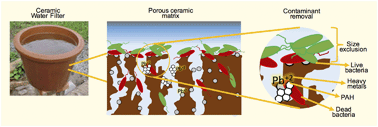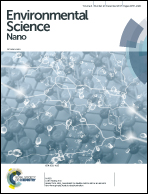Understanding the microbiological, organic and inorganic contaminant removal capacity of ceramic water filters doped with different silver nanoparticles†
Abstract
Pathogen removal efficacy of ceramic water filters (CWF) impregnated with silver nanoparticles (nAg) has been well studied, however scarce information is available about the impact of nAg surface functionalization and removal of inorganic and organic pollutants. In this study, we examined the effect of nAg functionalized with casein, maltose and phyto-extracts on the microbiological (Escherichia coli), organic (polycyclic aromatic hydrocarbon, PAH) and inorganic (heavy metals) simultaneous removal using disks manufactured in the laboratory. Results showed that the mass of nAg retained on each disk varied depending on the nanoparticles used (casein-nAg: 80%, maltose-nAg: 93%, and rosemary-nAg: 95%). Untreated CWF disks had a bacterial mass rejection (Rmass) of 95.97%, while nAg impregnated showed values above 99%. Bacteria log removal values (LRV) varied with the type of nanoparticle applied to the disks, rosemary-nAg impregnated disks attained the highest value among all the nAgs tested. In terms of lead removal, non-impregnated Red Art disks had a Rmass of 61%, while the nAg impregnated filters removed 74%, 72%, and 69%, for disks impregnated with casein-nAg, rosemary-nAg, and maltose-nAg, respectively. PAH removal was most effective in unmodified clay (72%), while modified disks had removal of 72% for casein-nAg, 67% for rosemary-nAg, and 69% for maltose-nAg. Mass removal rates of fluorene were determined at 73.38% for unmodified disks, while 74% for casein-nAg, 69% in rosemary-nAg, and 72% in maltose-nAg modified disks. nAg treated disks exhibited no statistical difference in PAH removal when compared to untreated. Application of nAg reduced the amount of culturable bacteria extracted from the surface an interior of the disks compared with unmodified disks. Results show that nAg impregnation increased the removal rates of E. coli and lead in the disks and that nAg average size and size distribution is an important factor in the removal rate of bacteria and lead in CWF.

- This article is part of the themed collection: Sustainable Nanotechnology Organization


 Please wait while we load your content...
Please wait while we load your content...